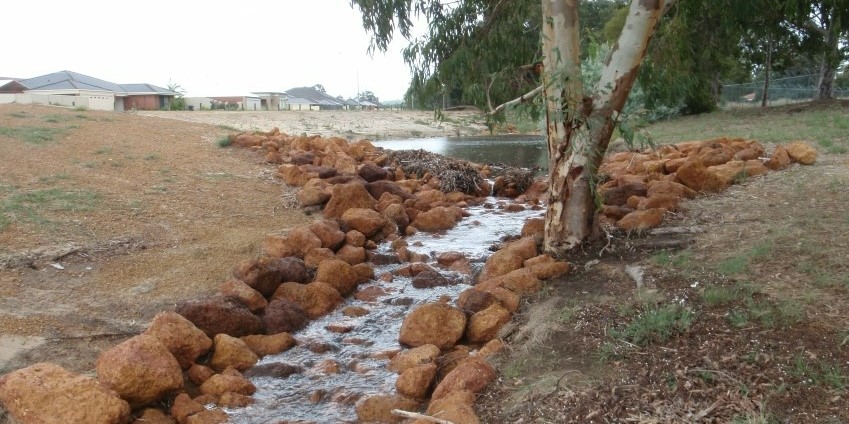The Department of Water and Environmental Regulation supports land planning authorities to integrate water and land use planning in ways that protect our environment and balance cultural, community and economic benefits, support population growth and state development.
We provide expertise and advice in land planning and other approval processes to ensure that water resources, including waterways, are appropriately considered by agencies that approve land use activities or manage land near waterways.
Waterways foreshore areas
Show moreProtection and management of foreshore areas is essential for maintaining healthy waterways (and their connected wetlands), and sustaining the environmental, social, cultural and economic services they provide.
A foreshore area is the land that adjoins or directly influences a waterway. More specifically, it is the area of transition between the edge of the waterway and the furthest extent of riparian vegetation, flood prone land, and riverine landforms. It may also be a negotiated area endorsed by the Department of Water and Environmental Regulation (or the Department of Biodiversity, Conservation and Attractions within or abutting the Swan and Canning Development Control Area).
Foreshore areas are also referred to as river buffers, river corridors, riparian buffers, riparian zones, riparian corridors or stream buffers in other states. Where a waterway foreshore area is to be set aside as a reserve under planning legislation, it is described as a foreshore reserve.
An appropriate foreshore area is designed to:
- maintain or improve the physical and biological features, functions and services of the waterway
- enable future restoration when restoration is recommended for degraded waterways, which may include restoring meanders in a straightened waterway
- allow compatible land uses and related development activities to occur.
To perform its many protective functions, a foreshore area must retain its native riparian vegetation, or be revegetated in a way that mimics the native vegetation that would have occurred there naturally, including the species, plant diversity and vegetation structure. A vegetated foreshore area traps nutrients and sediments, improves water quality, and reduces the risk and impact of erosion and sedimentation on waterways. It provides aquatic (when flooded), riparian (fringing) and terrestrial habitat for native flora and fauna, forms ecological linkages across the broader landscape and provide amenity, scenic and landscape values.
Further reading
Operational policy 4.3: Identifying and establishing waterways foreshore areas
River Restoration Manual: Chapter 16 - Determining foreshore reserves
Water note 23: Determining foreshore reserves
Urban waterways
Show moreUrban waterways are waterways in our cities and suburbs, including natural and constructed features that form part of a drainage system, and associated water bodies.
Urban waterways can include rivers and estuaries; sections that are open unlined drainage channels, concrete drains or closed pipes; wetlands, lakes; compensating basins and sumps; and water sensitive urban design structures such as rain gardens and swales.
Traditional urban drainage systems were designed to reduce local flooding by channelling stormwater quickly to rivers, wetlands, oceans or basins. However, this approach has negative environmental and social impacts linked to pollution, including algal blooms that can harm wildlife and prevent recreational use of water bodies.
We focus on improving stormwater management to achieve multiple outcomes, including improved water quality, protected ecosystems, and liveable and attractive communities.
We support water sensitive urban design which incorporates water cycle management into the urban environment, in a way that enhances environmental and social values.
Further reading
Urban drains to living streams
Show moreA living stream is a constructed or retrofitted waterway that mimics the characteristics of a natural stream. It may be a narrow creek which runs only in winter, a permanent stream, or a large river.
Whatever its size, a living stream has characteristics that distinguish it from a simple drain.
It has stable banks with riparian and aquatic vegetation, that provide habitats for native animals such as macroinvertebrates, fish and crayfish, frogs and waterbirds. It can also provide a beautiful feature of the landscape for people to enjoy.
In the past, many natural streams were converted to open drains and carried polluted water, and sediment to our receiving water bodies such as the Swan Estuary. They were often ugly and hazardous with steep banks, which meant they had to be fenced from public access. However, in recent years, due to recognition of the beneficial effect that streams have on water quality and the urban landscape, many drains have been restored to become living streams.
Benefits include:
- Erosion control – riparian and aquatic vegetation, pools and riffles, and a meandering shape create 'roughness' which slows the water, reducing its capacity to cause erosion and transport sediment.
- Water quality improvement – aquatic vegetation and natural biological processes help to oxygenate the water, remove nutrients and contaminants and thus improve water quality.
- Habitat – a living stream provides a diverse range of aquatic habitat for a plants and animals. It also provides a corridor of land and water along which many animals can move.
- Education – living streams provide education opportunity for local schools, TAFE colleges and universities. They provide opportunities to research the behaviour of the plants and animals which live side by side with humans.
- Recreation – living streams provide refuges for people as well as wildlife. They provide a range of recreational opportunities, including bird watching, bush walking, and the simple exploration of nature. They can be shady green corridors through housing developments, that cool the urban environment and provide places to relax and enjoy.
We have been involved in the restoration of several urban drains. You can read about the restoration of the Bannister Creek urban stream on the CRC Water Sensitive Cities website.
Further reading
Stormwater management manual: Chapter 9 - Structural controls; 4.3 Living streams
Stormwater management manual: Chapter 6 - Retrofitting



